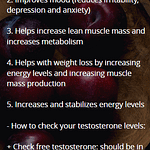High-intensity interval training increases testosterone levels
One way to boost your testosterone levels is with high-intensity interval training. These workouts, also called HIIT, turn your entire body into a muscle factory. Testosterone is a male hormone that gives people male features and helps develop the male reproductive tissues during puberty. The best part about HIIT is that it’s not difficult to start.
HIIT is a type of anaerobic exercise that involves short bursts of intense exercise followed by periods of rest. The idea is to generate an oxygen debt and recovery deficit in the body so that it can sustain a higher metabolism for hours. Research shows that HIIT increases both testosterone and HGH, the human growth hormone.
Another way to increase testosterone is resistance training. Resistance training increases testosterone levels temporarily and can change the way fat is distributed in the body. In addition to increasing testosterone levels, regular exercise can improve mood and muscle mass. Researchers have found that regular physical activity can reduce levels of cortisol, a hormone that is linked to stress.
Researchers have found that HIIT increases testosterone levels in men. In their study, testosterone levels increased immediately after the HIIT workout. Cortisol levels decreased after HIIT sessions. Cortisol levels returned to normal levels after 60 minutes. The effects were mediated by HIIT components and participant characteristics.
HIIT and sprinting are two of the best ways to increase testosterone levels. These workouts involve intense bursts of cardio followed by short rest periods. They’ll also help you build lean muscle mass and improve cardiovascular health. All of these factors make HIIT workouts a great way to increase your testosterone levels naturally.
High-intensity interval training increases the level of testosterone in men, but you must be sure your body has adequate levels of testosterone before beginning a testosterone workout. The good news is that your testosterone levels will adjust to the workout. It’s best to see a physician to determine if your testosterone levels are low and find a healthy balance.
Regular exercise helps improve hormone levels, but the types of exercise that boost testosterone are short and challenging. It’s also important to get plenty of rest between workouts. Doing short and intense workouts helps you prevent lifestyle-related diseases and boost testosterone levels naturally.
Weight training reduces fat

Men who exercise regularly can boost their testosterone levels, reduce fat, and improve their metabolism. However, to get these benefits, men should focus on all the muscle groups. This way, they don’t overwork themselves and risk getting injured. For this reason, they should always seek the guidance of a qualified trainer.
The level of testosterone in men can vary, based on age, gender, fitness level, and weight. You should also determine your recovery rate, and whether you’re fit enough to exercise. Women tend to have lower testosterone levels than men, but weight training can help them gain lean muscle mass and strength.
Testosterone is an important hormone that signals the body to produce more lean muscle. It increases protein synthesis, which leads to faster growth of muscle tissue. However, if your testosterone is low, your body won’t have the ability to properly repair itself. Low levels of testosterone will also make it difficult to adapt to exercise, leading to chronic fatigue.
The right combination of strength training and cardio exercise can help men burn fat and increase testosterone. Strength training should be part of your routine two to three days a week, paired with restorative movements and aerobic exercises. Progress is more important than perfection, so try new exercises slowly until you’re comfortable with them.
A study conducted at the Charles R. Drew University of Medicine and Science found that testosterone fluctuations have a significant impact on body fat percentage. Higher levels of testosterone lead to leaner men while lower levels lead to fatter men. While the mechanisms aren’t fully understood, there’s one thing we do know for sure: testosterone inhibits the creation of fat cells.
Testosterone treatment doesn’t improve erections in men with low testosterone levels
It’s not uncommon for men to suffer from ED – erectile dysfunction – due to low levels of testosterone. These men often suffer from difficulty in achieving firm erections and experiencing decreased libido. However, testosterone treatment for ED is not always the best solution. Studies show that testosterone treatment doesn’t increase erections in men with low levels of the hormone.
While testosterone treatment can help improve erections in most men, there are also risks of prostate cancer and cardiovascular disease. Some doctors recommend regular exams to check for these risks. Another risk is that testosterone may affect fertility, so men who are trying to get pregnant may want to discuss using alternative medicine with their physician.
Low testosterone can also cause mood swings and other health problems. Men with low testosterone may feel tired, unfocused, and may experience a lack of motivation. They may also have trouble concentrating, are unfocused, or may experience a decrease in libido. These side effects can make it difficult to conceive and maintain a strong erection.
If you’ve been experiencing difficulty getting erections for three months or more, you should visit your doctor. He will do a physical exam and ask about any symptoms that you’re experiencing. If your doctor thinks that your problem is a testosterone deficiency, he may prescribe testosterone treatment.
Testosterone treatment for low testosterone can come in the form of a skin patch, a cream, or a pill. If the treatment is administered by injection, your doctor may want to check your testosterone levels at different intervals, especially during periods of treatment. This will ensure that you are not boosting your levels too much.
A blood test is an effective way to detect low testosterone levels and rule out other medical conditions. A doctor will discuss your symptoms with you and perform a blood test to make sure you don’t have any other underlying conditions that may be affecting your ability to get an erection.
Men with low testosterone levels should consult with a male reproductive specialist. He will examine you for hair growth and muscle development and may order semen analysis. Your healthcare provider may also run a low T test to check if you’re at risk for HIV or diabetes. Treatment for low testosterone is relatively simple and involves replacing the missing testosterone in the body. However, it’s important to note that testosterone treatment doesn’t work for all men.
Side effects of testosterone therapy
While testosterone hormone treatment has benefits and risks, most men find it safe and effective. The process can affect cognitive and neurological functions. It can also have negative effects on blood chemistry, so it’s important to consult with a physician to determine the best course of action. There are different methods of testosterone therapy, including pills, gels, and patches.
There are some side effects of testosterone therapy, such as skin rashes, acne, and hair growth. It may also worsen symptoms of sleep apnea. If you suspect you have sleep apnea, you should get a sleep study and try continuous positive airway pressure. The use of testosterone can also increase the risk of breast enlargement. Another side effect of testosterone therapy is skin reactions to the testosterone gel.
Testosterone therapy can also lead to cardiovascular problems. Some studies show that men taking testosterone therapy have an increased risk of strokes and heart attacks. In fact, the Testosterone in Older Men study was stopped early because of these side effects. Despite the potential risks, testosterone therapy is still the best choice for many men.
Despite its negative side effects, testosterone therapy may also have beneficial effects on brain development. It has been shown to improve the cognitive ability and memory in patients with multiple sclerosis. In addition, the treatment may delay the progression of the disease, as it may protect nerve cells. However, some doctors worry that testosterone therapy may promote the growth of prostate cancer cells.
Some men taking testosterone injections report a slight increase in aggression. They also report skin color changes, difficulty urinating, and breast tenderness. Another common side effect of testosterone therapy is the increase in cholesterol, which can lead to acne. This cholesterol increase can be minimized by using skin patches.
Another treatment option for testosterone therapy is testosterone pellets. These tiny pellets are implanted under the skin near the hip, releasing testosterone slowly over a period of three to six months. This type of testosterone therapy should be long-acting, and should produce stable levels of hormone for about four months.








